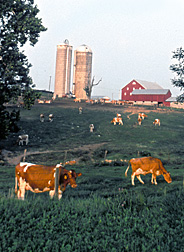|

A new vaccine against a
parasite-borne disease called neosporosis that costs cattle producers millions
of dollars a year may be a few steps closer to development, thanks to
Agricultural Research Service (ARS) scientists and cooperators. Click the
image for more information about it.
|
|

|
Test Vaccines Show Promise against Parasite of
Cattle
By Ann
Perry July 29, 2008
An effective vaccine against a parasite-borne disease called
neosporosis may be a few steps closer to development, thanks to
Agricultural Research Service (ARS)
scientists and cooperators.
Neosporosis, caused by the parasite Neospora caninum, affects
cattle worldwide. Infected animals often abort their calves and develop other
debilitating complications that can cost producers millions of dollars every
year.
Animal scientist
Wenbin
Tuo and microbiologist
Mark
Jenkins work at the ARS
Animal
Parasitic Diseases Laboratory in Beltsville, Md. They collaborated with ARS
Molecular
Plant Pathology Laboratory molecular biologist
Yan
Zhao and National Institutes of Health
researcher Daming Zhu to test a new neosporosis vaccine in a mouse model.
The team created the vaccine using the parasite’s own proteins.
One of these proteins, called Neospora caninum cyclophilin (NcCyP),
regulates the response of the host immune system that limits the survival of
the parasite in the host after infection. The other protein--called NcSRS2--
helps the parasite attach to and invade host cells.
The researchers tested three different vaccine cocktails containing
these proteins. One group of mice received a formulation of NcCyP. A second
group received a formulation of NcSRS2. A third group was immunized with a mix
of both proteins. After vaccination, the mice were inoculated with the
parasite.
The researchers found mice that received the vaccine formulated with
NcCyP alone exhibited the highest levels of protection against the disease. On
average, only 13 percent of the mice in this group had detectable levels of
N. caninum in brain tissue following infection. In contrast, more than
80 percent of the non-vaccinated mice were infected after challenge.
The scientists found that the serum antibody levels against the
protein correlated well with the levels of protection. They also observed that
the vaccine containing both NcCyP and NcSRS2 was no more effective than the
vaccine that just contained NcCyP. However, more work is needed to evaluate the
efficacy of these proteins in protecting cattle--the host animal--against the
disease.
Results from this research were presented in earlier this month at the
53rd annual conference of the American Association of Veterinary
Parasitologists in New Orleans, La.
ARS is a scientific research agency of the
U.S. Department of
Agriculture.